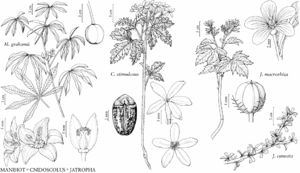Difference between revisions of "Jatropha macrorhiza"
Pl. Hartw., 8. 1839.
FNA>Volume Importer |
FNA>Volume Importer |
||
| Line 16: | Line 16: | ||
|name=Jatropha arizonica | |name=Jatropha arizonica | ||
|authority=I. M. Johnston | |authority=I. M. Johnston | ||
| − | }}{{Treatment/ID/Synonym | + | }} {{Treatment/ID/Synonym |
|name=J. macrorhiza var. septemfida | |name=J. macrorhiza var. septemfida | ||
|authority=Englemann | |authority=Englemann | ||
| Line 34: | Line 34: | ||
|elevation=1000–2600 m. | |elevation=1000–2600 m. | ||
|distribution=Ariz.;N.Mex.;Tex.;Mexico (Chihuahua;Sonora). | |distribution=Ariz.;N.Mex.;Tex.;Mexico (Chihuahua;Sonora). | ||
| − | |discussion=<p>Jatropha macrorhiza is known in Texas only from a single collection made in Presidio County in 1938; it is common in nearby Chihuahua and appears to be native to trans-Pecos Texas, but may now be extirpated there.</p><!-- | + | |discussion=<p><i>Jatropha macrorhiza</i> is known in Texas only from a single collection made in Presidio County in 1938; it is common in nearby Chihuahua and appears to be native to trans-Pecos Texas, but may now be extirpated there.</p><!-- |
--><p>Plants from the United States often have been called var. septemfida, named in reference to having seven (as opposed to five) leaf lobes or segments. However, leaf segment number varies, even on the same plant, from four to nine (usually five to seven). Hence, a distinct variety cannot be recognized. R. McVaugh (1945) reported this species to have ten stamens; I have not seen any live or herbarium specimens with ten; two collections have recorded nine.</p> | --><p>Plants from the United States often have been called var. septemfida, named in reference to having seven (as opposed to five) leaf lobes or segments. However, leaf segment number varies, even on the same plant, from four to nine (usually five to seven). Hence, a distinct variety cannot be recognized. R. McVaugh (1945) reported this species to have ten stamens; I have not seen any live or herbarium specimens with ten; two collections have recorded nine.</p> | ||
|tables= | |tables= | ||
| Line 59: | Line 59: | ||
|publication year=1839 | |publication year=1839 | ||
|special status=Selected by author to be illustrated | |special status=Selected by author to be illustrated | ||
| − | |source xml=https://jpend@bitbucket.org/aafc-mbb/fna-data-curation.git/src/ | + | |source xml=https://jpend@bitbucket.org/aafc-mbb/fna-data-curation.git/src/8f726806613d60c220dc4493de13607dd3150896/coarse_grained_fna_xml/V12/V12_744.xml |
|genus=Jatropha | |genus=Jatropha | ||
|species=Jatropha macrorhiza | |species=Jatropha macrorhiza | ||
Revision as of 14:49, 18 September 2019
Herbs, perennial, to 0.5 m, monoecious, with ± fleshy subterranean caudex to 11 cm diam., stem and root scars round. Stems erect, green, usually sparsely branched, herbaceous, somewhat succulent, glabrous; short shoots absent; latex watery, colorless. Leaves ± evenly distributed on long shoots; stipules persistent, 4–10 mm, filiform-divided; petiole 4.8–10.5(–13.5) cm, not stipitate-glandular; blade cordate in outline, 11–16 × 9.3–11.2 cm, (3–)5–7(–9)-lobed to middle, base cordate, margins coarsely dentate, apex acuminate, membranous, abaxial surface glabrous, adaxial glabrous, except puberulent on veins, margins sometimes puberulent or with setae; venation palmate. Inflorescences bisexual, terminal and subterminal, cymes; peduncle 1.5–4.5 cm; bracts (6–)8–16 mm, margins serrate, glabrous. Pedicels 2.5–4 mm. Staminate flowers: sepals distinct or connate to 1/2 length, lanceolate, 5–7 × 1–2 mm, margins deeply divided, apex acuminate, surfaces glabrous; corolla light pink, often with white striations, rotate, petals distinct or connate 1/4 length, 8–11.5 × 2.5–4.5 mm, surfaces glabrous; stamens 8(–9) in 2 whorls (5 + 3); filaments of outer whorl distinct, of inner whorl connate to 1/2 length, outer whorl 3.5–6 mm, inner whorl 4.5–9 mm. Pistillate flowers resembling staminate, but slightly larger; carpels 3; styles distinct or connate only at base, 3.5–4 mm. Capsules ± spheric, 1.2–1.3 × 1.2–1.3 cm, distinctly 3-lobed, explosively dehiscent. Seeds pale gray, ellipsoidal, 8–9 × 6–6.5 mm; caruncle prominent. 2n = 22.
Phenology: Flowering and fruiting spring–summer.
Habitat: Hillsides, mesas, sandy washes.
Elevation: 1000–2600 m.
Distribution
Ariz., N.Mex., Tex., Mexico (Chihuahua, Sonora).
Discussion
Jatropha macrorhiza is known in Texas only from a single collection made in Presidio County in 1938; it is common in nearby Chihuahua and appears to be native to trans-Pecos Texas, but may now be extirpated there.
Plants from the United States often have been called var. septemfida, named in reference to having seven (as opposed to five) leaf lobes or segments. However, leaf segment number varies, even on the same plant, from four to nine (usually five to seven). Hence, a distinct variety cannot be recognized. R. McVaugh (1945) reported this species to have ten stamens; I have not seen any live or herbarium specimens with ten; two collections have recorded nine.
Selected References
None.
